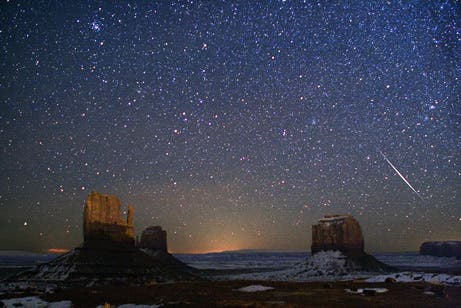Heralded by NASA as the best meteor shower of the year, the annual Geminid skyline spectacle is set to peak tonight, part of a show that shouldn’t be missed. Passionate night gazers, however, will have to battle low temperatures and a bright sky, lit by the passing full moon.
The Geminids are expected to streak across the skies between Dec. 12 and 16, the most spectacular view occurring tonight, Dec. 13, when the meteor shower will be at its peak. As such, today between 80 and 120 shooting stars per hour will be seen in the night sky, although scientists warn that the moon’s bright aura, left over from the recent total lunar eclipse, will obstruct much of the view, rendering many of the falling stars invisible.
“This year, folks will get a nice double whammy with the lunar eclipse on the 10th, and then the Geminid peak on the night of the 13th, but it would be nice if we could just turn off the moon after the eclipse,” Bill Cooke, head of the Meteoroid Environments Office at NASA’s Marshall Space Flight Center in Huntsvilla, Ala..
The Geminid meteor shower takes place during the middle of December each year, as a result of debris flybys from an object called 3200 Phaetheon, which has an asteroid-like orbit and has been passing near the Earth since 1830s. Back then peak intensity was of about 20 meteors per hour, compared to 120 meteors per hour today.
The Quadrantids will be the next major meteor shower; skywatchers can expect these to peak on the night of Jan. 3, 2012.
Note to ZME Science readers: if you happen to catch a photo of the Geminid shower, please consider sharing it with us and, as such, with the other ZME readers by e-mailing it to [email protected]. Thank you!










